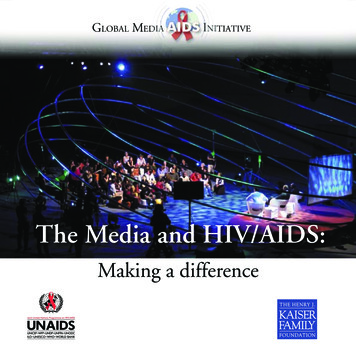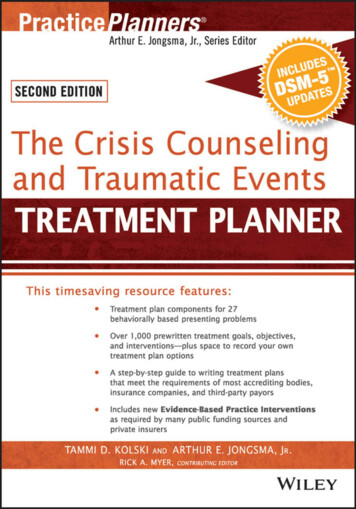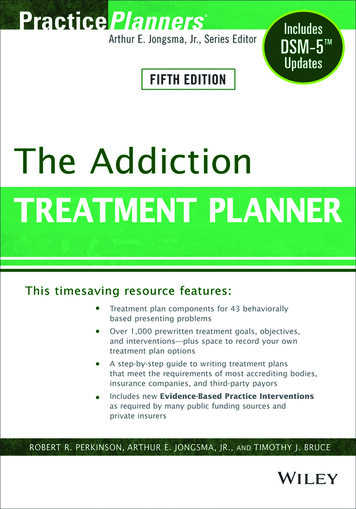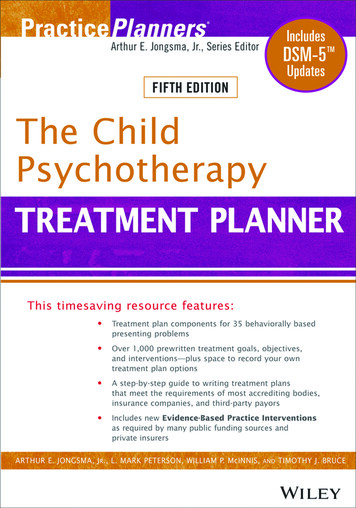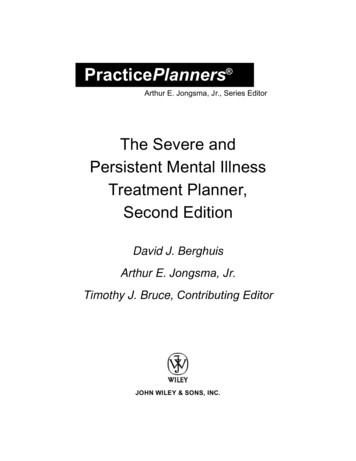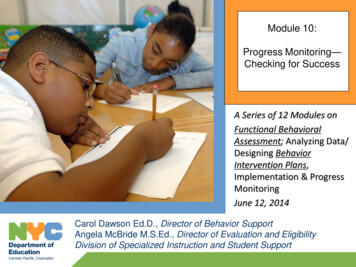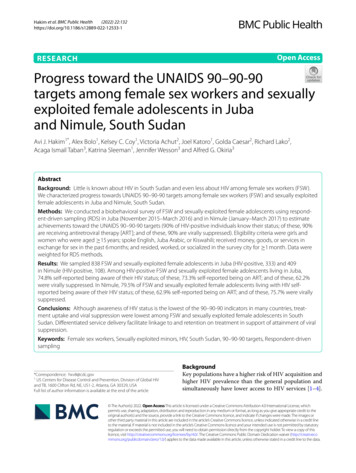
Transcription
(2022) 22:132Hakim et al. BMC Public en AccessRESEARCHProgress toward the UNAIDS 90–90-90targets among female sex workers and sexuallyexploited female adolescents in Jubaand Nimule, South SudanAvi J. Hakim1*, Alex Bolo1, Kelsey C. Coy1, Victoria Achut2, Joel Katoro1, Golda Caesar2, Richard Lako2,Acaga Ismail Taban3, Katrina Sleeman1, Jennifer Wesson3 and Alfred G. Okiria3AbstractBackground: Little is known about HIV in South Sudan and even less about HIV among female sex workers (FSW).We characterized progress towards UNAIDS 90–90-90 targets among female sex workers (FSW) and sexually exploitedfemale adolescents in Juba and Nimule, South Sudan.Methods: We conducted a biobehavioral survey of FSW and sexually exploited female adolescents using respondent-driven sampling (RDS) in Juba (November 2015–March 2016) and in Nimule (January–March 2017) to estimateachievements toward the UNAIDS 90–90-90 targets (90% of HIV-positive individuals know their status; of these, 90%are receiving antiretroviral therapy [ART]; and of these, 90% are virally suppressed). Eligibility criteria were girls andwomen who were aged 15 years; spoke English, Juba Arabic, or Kiswahili; received money, goods, or services inexchange for sex in the past 6 months; and resided, worked, or socialized in the survey city for 1 month. Data wereweighted for RDS methods.Results: We sampled 838 FSW and sexually exploited female adolescents in Juba (HIV-positive, 333) and 409in Nimule (HIV-positive, 108). Among HIV-positive FSW and sexually exploited female adolescents living in Juba,74.8% self-reported being aware of their HIV status; of these, 73.3% self-reported being on ART; and of these, 62.2%were virally suppressed. In Nimule, 79.5% of FSW and sexually exploited female adolescents living with HIV selfreported being aware of their HIV status; of these, 62.9% self-reported being on ART; and of these, 75.7% were virallysuppressed.Conclusions: Although awareness of HIV status is the lowest of the 90–90-90 indicators in many countries, treatment uptake and viral suppression were lowest among FSW and sexually exploited female adolescents in SouthSudan. Differentiated service delivery facilitate linkage to and retention on treatment in support of attainment of viralsuppression.Keywords: Female sex workers, Sexually exploited minors, HIV, South Sudan, 90–90-90 targets, Respondent-drivensampling*Correspondence: hxv8@cdc.gov1US Centers for Disease Control and Prevention, Division of Global HIVand TB, 1600 Clifton Rd, NE, US1‑2, Atlanta, GA 30329, USAFull list of author information is available at the end of the articleBackgroundKey populations have a higher risk of HIV acquisition andhigher HIV prevalence than the general population andsimultaneously have lower access to HIV services [1–4]. The Author(s) 2022. Open Access This article is licensed under a Creative Commons Attribution 4.0 International License, whichpermits use, sharing, adaptation, distribution and reproduction in any medium or format, as long as you give appropriate credit to theoriginal author(s) and the source, provide a link to the Creative Commons licence, and indicate if changes were made. The images orother third party material in this article are included in the article’s Creative Commons licence, unless indicated otherwise in a credit lineto the material. If material is not included in the article’s Creative Commons licence and your intended use is not permitted by statutoryregulation or exceeds the permitted use, you will need to obtain permission directly from the copyright holder. To view a copy of thislicence, visit http:// creat iveco mmons. org/ licen ses/ by/4. 0/. The Creative Commons Public Domain Dedication waiver (http:// creat iveco mmons. org/ publi cdoma in/ zero/1. 0/) applies to the data made available in this article, unless otherwise stated in a credit line to the data.
Hakim et al. BMC Public Health(2022) 22:132Key populations and their partners account for over halfof new HIV infections globally despite accounting foronly a fraction of the population [5]. For female sex workers (FSW) in particular, HIV prevalence has been associated with laws banning sex work [6]. Other factors thatincrease risk and vulnerability of sex workers and hinderutilization of HIV services include STIs, depression, andalcohol consumption. Sex work has further been found tocontribute to epidemic dynamics even in high HIV prevalence settings, reinforcing the notion that HIV servicesneed to reach all populations [7].The Joint United National Programme on HIV/AIDS(UNAIDS) call for diagnosing 90% of all people livingwith HIV (PLHIV), sustaining 90% of them on antiretroviral therapy (ART), and maintaining viral suppression among 90% of those receiving ART [8]. AlthoughUNAIDS targets are set for all populations, global effortsto reach and measure progress toward these targets havefocused on the general population [9–11]. Consequently,little is known about progress toward reaching 90–90-90targets among key populations, including FSW. Becausestigma hinders HIV service utilization and may promptkey population members who access them to concealtheir behaviors, program data alone are insufficient tocharacterize the epidemic among key populations [12].HIV prevalence among individuals aged 15–49 years inSouth Sudan is estimated at 2.4%, and there are approximately 194,000 PLHIV, less than one in five of whom areon ART [13]. HIV prevalence among FSW in Juba, thecapital, was estimated at 37.9% and at 24.0% in Nimule,on the major border crossing with Uganda [14, 15].Syphilis prevalence was 7.3% in Juba and 9.2% in Nimule[14, 15]. The illegal nature of sex work in South Sudanexposes FSW to arrest and harassment from police andother security forces, in addition to violence from clients [16, 17]. Approximately two-thirds of FSW in Jubaand one-quarter in Nimule were foreign, adding furtherstigma and barriers to service utilization [14, 15].Though a country for less than 10 years, South Sudanhas moved quickly to develop its HIV surveillance system to inform the government’s HIV response. We present findings from the Eagle Survey of FSW and sexuallyexploited female adolescents in Juba and Nimule andcharacterize progress toward reaching the UNAIDS90–90-90 targets among this population.MethodsStudy population, setting, and designThe Eagle Survey used respondent-driven sampling(RDS) to recruit FSW and sexually exploited femaleadolescents in Juba (November 2015–March 2016) andin Nimule (January–March 2017). RDS was chosento recruit participants because sex work is illegal andPage 2 of 11sex workers stigmatized, FSW had social connectionsacross sub-groups, and for the safety of FSW and studystaff. Sexually exploited female adolescents were definedas those aged 15–17 years who were engaged in sex inexchange for goods, money, or services. RDS is a variantof snowball sampling used to produce sampling weightsand approximate a random sample [18–21]. Eligibilitycriteria were girls and women who were aged 15 years;spoke English, Juba Arabic, or Kiswahili; receivedmoney, goods, or services in exchange for sex in the past6 months; and resided, worked, or socialized in the survey city for at least the last 1 month.Recruitment and data collectionData collection began with four seeds selected basedon age, neighborhood, nationality, and influence amongpeers. Five more seeds were later added to reach underrepresented populations. After completing eligibilityscreening and providing verbal informed consent, participants underwent a face-to-face computer-assistedpersonal interview (Open Data Kit, Washington, US).Interview domains included demographics, experienceof stigma, HIV knowledge, sexual history, uptake ofHIV and sexually health services, and history of sexuallytransmitted diseases. The two-item Patient Health Questionnaire (PHQ-2) was used to screen for depression, andthe three-question Alcohol Use Disorders IdentificationTest was used to screen for alcohol disorders [22, 23].Determination of comprehensive knowledge of HIV utilized the UNAIDS definition [24].Upon completion of the interview, consenting participants were tested for HIV by trained staff accordingto the national testing algorithm of Determine HIV-1/2(Alere, MA, USA) followed by Uni-Gold (Trinity Biotech,Ireland) for reactive results to confirm HIV infection.Bioline (Standard Diagnostics, South Korea) was usedas a tiebreaker for discrepant results. Participants withHIV received CD4 enumeration with the PIMA analyzer(Alere, MA, USA). Quality control of HIV-positive specimens was performed with Geenius HIV-1/2 (Bio-Rad,CA) at the South Sudan National Public Health Lab. Viralload testing was performed on dried blood spot samplesat US Centers for Disease Control and Prevention (CDC;Atlanta, GA) using the Abbott RealTime HIV-1 assay(Abbott Molecular, IL) on the Abbott m2000 fully-automated platform.Syphilis testing was conducted using Bioline syphilis 3.0 followed by the Rapid Plasma Reagin (RPR) test.Participants testing positive for HIV were given a referral letter to ART sites for treatment; those testing positive for syphilis were treated at the study site. Staff weretrained to refer all girls aged younger than 18 years to
Hakim et al. BMC Public Health(2022) 22:132partner organizations providing psychosocial and otherprotection services for sexually exploited minors.Participants were compensated 60 South SudanesePounds (SSP, approximately 20 USD at the time of datacollection) and given three coupons to recruit peers. Atthe second study visit they received 20 SSP for transportation and 15 SSP for each successful recruit (approximately 21 USD maximum).Data analysisThe primary endpoint for our analysis was awareness ofHIV-positive status. The analysis was restricted to HIVpositive participants, and suppressed HIV viral load wasdefined as 1000 copies/mL. Estimates of geometricmean viral load excluded values below the limit of detection (831 copies/mL) and those with a result of target notdetected to avoid underestimating the mean. Estimatesof median viral load do include values below the limit ofdetection (831 copies/mL) and those with a result of target not detected (TND).Data were analyzed using RDS Analyst version 0.62(Los Angeles, CA) using Gile’s Successive SamplingEstimator and SAS v9.4. Network size was determinedthrough a series of questions that ultimately asked participants about the number of other female sex workersaged 15 years they knew in the study city and had seenin the last month. Diagnostics were conducted to assessthe sample’s independence from seeds. RDS samplingweights were used in the calculation of odds ratios (OR)and 95% confidence intervals (CI) for bivariate comparisons, and variables significant at p 0.1 were included inthe weighted multivariable model.We explored the impact of self-reporting on cascadeestimates and present the 90–90-90 conditional cascadein two ways: 1) where inclusion in a step is based on selfreported response to the previous step and 2) where allparticipants with suppressed HIV viral load are considered to also be aware of their status and on antiretroviral therapy, with conditional cascade measures modifiedaccordingly.Ethical approvalEthical approval for the Eagle Survey was obtained fromthe South Sudan Ministry of Health Ethical ReviewBoard. The protocol was also reviewed by the CDCCenter for Global Health Associate Director for Sciencein accordance with CDC human research protection procedures and was determined to be research, but CDCinvestigators did not interact with human subjects orhave access to identifiable data or specimens for researchpurposes. The South Sudan Ministry of Health EthicalReview Board and the CDC Center for Global HealthAssociate Director for Science approved of the use ofPage 3 of 11verbal informed consent because written consent wouldbe the only identifiable information collected and couldpose a risk to participants. A waiver to obtain informedconsent from parents or guardians of participants underthe age of 18 was granted as the risks of participationwere minimal and outweighed by the potential risks ofdisclosure of sex work to parents or guardians. All methods were performed in accordance with the relevantguidelines and regulations.ResultsWe sampled 838 FSW and sexually exploited female adolescents in Juba (HIV-positive, 333) and 409 in Nimule(HIV-positive, 108). Sexually exploited female adolescents were defined as those aged 15–17 years who wereengaged in sex in exchange for goods, money, or services.Among FSW and sexually exploited female adolescentsliving with HIV in Juba, 74.8% self-reported being awareof their HIV status; of these, 73.3% self-reported beingon ART; of these, 62.2% were virally suppressed (Fig. 1a).When adjusted for viral suppression, 80.5% of FSW andsexually exploited female adolescents were aware of theirHIV status; of these, 81.8% were on ART; and of these,70.1% were virally suppressed. Viral suppression amongall FSW and sexually exploited female adolescents livingwith HIV in Juba, regardless of awareness and ART status, was 41.1% (95% CI: 34.4–47.8). The geometric meanviral load among those with measurable viral load was8844 copies/mL (95% CI: 6589-11,871), and 59.3% (95%CI: 52.5–66.0) of all FSW and sexually exploited femaleadolescents in Juba had VL 1000 copies/mL. Medianviral load was 2318 copies/mL (interquartile range [IQR],831–22,908).In Nimule, 79.5% of FSW and sexually exploited femaleadolescents living with HIV self-reported being aware oftheir HIV status; of these, 62.9% self-reported being onART; of these, 75.7% were virally suppressed (Fig. 1b).When adjusted for viral suppression, 91.4% of FSW andsexually exploited female adolescents were aware of theirHIV status; of these, 80.3% were on ART; and of these,86.3% were virally suppressed. Viral suppression amongall FSW and sexually exploited female adolescents living with HIV in Nimule, regardless of awareness andART status, was 52.8% (95% CI: 41.7–63.9). The geometric mean viral load among those with measurableviral load was 9955 copies/mL (95% CI: 5726-17,309),and 47.2% (95% CI: 36.1–58.4) of all FSW and sexuallyexploited female adolescents in Nimule had VL 1000copies/mL. Median viral load was 831 copies/mL (IQR,TND-22,908).Among FSW and sexually exploited female adolescentsliving with HIV in Juba, awareness of HIV status was81.0% among those aged 15–24 years and 72.6% among
Hakim et al. BMC Public Health(2022) 22:132Page 4 of 11Fig. 1 a Conditional HIV Treatment Cascade Among Female Sex Workers in Juba, South Sudan. b. Conditional HIV Treatment Cascade AmongFemale Sex Workers in Nimule, South Sudanthose aged 35 years (Table 1). In Nimule, 90.7% of thoseaged 15–24 years and 95.6% of those aged 35 years wereaware of their HIV status. Although 62.3% of South Sudanese FSW and sexually exploited female adolescents inJuba were aware of their HIV status, in Nimule 100.0%were. Non-Sudanese accounted for 85.7% of HIV-positiveFSW and sexually exploited female adolescents in Jubaand 70% in Nimule. Awareness among non-South Sudanese FSW and sexually exploited female adolescents was
Hakim et al. BMC Public Health(2022) 22:132Page 5 of 11Table 1 Characteristics of HIV-positive female sex workers at each stage of the conditional 90–90-90 cascade in Juba and Nimule,South Sudan, 2015–2016JubaNimuleHIV PositiveHIV-positiveaware aOn treatmentaSuppressedviral loadHIV PositiveHIV-positiveaware aOn treatmentaSuppressedviral loadN 333N 233N 190N 126N 108N 82N 69N 58n (%; 95% CI)n (%; 95% CI)n (%; 95% CI)n (%; 95% CI)n (%; 95% CI)n (%; 95% CI)n (%; 95% CI)n (%; 95% CI)15–2433 (11.1;6.7–15.5)22 (81.0;65.6–96.5)14 (59.6;35.0–84.2)10 (80.3;55.9–100.0)15 (14.6;6.5–22.6)10 (90.7;74.8–100.0)5 (51.1;15.2–86.9)4 (100.0;88.4–100.0)25–34192 (58.6;52.0–65.3)139 (84.7;78.5–90.9)114 (83.1;75.9–90.3)70 (65.6;55.6–75.7)60 (55.5;44.6–66.4)46 (89.6;80.7–98.5)39 (81.8;67.7–96.0)31 (80.0;66.7–94.1) 35102 (30.3;24.0–38.6)70 (72.6;61.4–83.8)61 (89.4;81.5–97.4)45 (75.3;62.3–88.3)33 (29.9;19.9–40.0)26 (95.6;86.9–100.0)25 (92.5;78.2–100.0)23 (94.9;84.9–100.0)No formaleducation133 (45.1;38.5–51.7)88 (79.1;70.7–87.4)71 (82.0;72.9–91.1)48 (71.4;59.7–83.1)57 (57.1;46.4–67.7)41 (98.7;96.1–100.0)36 (85.7;71.9–99.4)32 (86.9;74.3–99.5)Primary123 (35.2;28.8–41.5)89 (81.4;72.7–90.2)71 (79.4;68.8–90.1)45 (69.7;56.9–82.5)34 (28.5;19.0–38.1)28 (89.8;79.5–100.0)23 (76.8;56.3–97.4)17 (81.3;63.8–98.8)73 (19.7;14.7–24.7)55 (81.8;70.9–92.7)47 (85.5;74.6–96.3)32 (67.6;51.0–84.2)17 (14.4;6.9–21.9)13 (72.8;47.1–98.6)10 (67.1;34.6–99.5)9 (100.0)Yes265 (82.7;78.0–87.5)188 (81.0;75.1–86.9)153 (83.2;77.2–89.3)100 (70.6;62.2–79.0)91 (83.3;75.0–91.7)70 (90.5;83.3–97.6)62 (86.9;76.5–97.2)51 (84.6;74.1–95.0)No64 (17.3;12.5–22.0)44 (78.1;65.8–90.4)36 (75.1;57.5–92.6)25 (66.9;48.3–85.5)17 (16.7;8.3–25.0)12 (95.8;87.3–100.0)7 (49.4;17.1–81.8)7 (100.0;92.4–100.0)SouthSudanese42 (14.3;9.7–18.9)15 (62.3;40.1–84.4)12 (72.5;45.4–99.5)9 (67.1;34.3–99.8)28 (30.0;19.6–40.3)18 (100.0;97.4–100.0)16 (80.1;55.5–100.0)14 (93.8;81.6–100.0)Other287 (85.7;81.1–90.3)217 (82.4;77.1–87.7)177 (82.5;76.5–88.5)116 (70.2;62.3–78.1)80 (70.0;59.7–80.4)64 (88.6;80.5–96.6)53 (80.3;68.2–92.5)44 (83.5;71.6–95.4)Age (years)EducationHigh schoolor higherEver marriedNationalityAway from home for 1 month, past 6 monthsYes80 (25.4;19.2–31.6)67 (90.9;84.5–97.2)58 (85.7;74.6–96.9)39 (74.8;61.4–88.2)37 (32.1;22.3–41.9)26 (83.6;68.9–98.3)21 (85.6;72.1–99.2)17 (82.3;64.8–99.9)No249 (74.6;68.4–80.8)165 (76.5;69.8–83.2)131 (80.0;73.0–87.0)86 (67.7;58.5–76.9)71 (67.1;58.1–77.7)56 (95.3;90.1–100.0)48 (77.9;63.4–92.5)41 (88.3;77.4–99.2)Screened positive for depressionYes134 (39.5;33.0–46.1)92 (78.7;69.6–87.7)80 (87.8;80.0–95.5)56 (74.3;63.0–85.5)41 (40.4;29.6–51.2)32 (94.8;85.5–100.0)30 (89.8;75.0–100.0)28 (94.1;82.5–100.0)No193 (60.5;53.9–67.0)139 (82.2;75.8–88.7)108 (78.0;69.8–86.3)68 (66.9;56.7–77.2)66 (59.6;48.8–70.4)49 (89.0;80.7–97.2)38 (73.2;57.8–88.6)29 (79.6;65.4–93.8)Screened positive for alcohol abuse, AUDIT-CYes122 (36.6;30.4–42.9)94 (85.4;77.8–92.9)76 (80.2;70.0–90.3)48 (64.7;52.2–77.2)46 (39.8;29.3–50.5)34 (88.6;76.8–100.0)25 (70.9;51.8–89.9)22 (88.0;70.9–100.0)No206 (63.4;57.1–69.6)137 (77.6;70.4–84.7)112 (82.8;75.5–90.1)76 (73.3;63.7–82.9)62 (60.1;49.5–70.7)48 (93.2;86.6–99.7)44 (86.1;72.9–99.4)36 (85.5;74.3–96.7)Tested positive for syphilisYes53 (14.9;10.4–19.3)38 (87.9;78.4–97.5)34 (87.5;75.4–99.5)29 (82.3;66.3–98.3)28 (26.3;16.8–35.7)24 (99.1;97.2–100.0)19 (83.4;68.7–98.1)15 (78.2;55.8–100.0)No280 (85.1;80.7–89.6)195 (79.4;73.5–85.3)156 (80.9;74.3–87.5)97 (67.8;59.2–76.4)79 (73.7;64.3–83.2)58 (88.6;80.4–96.9)50 (79.1;64.9–93.2)43 (89.8;80.9–98.6)STI symptoms, last 12 monthsYes162 (47.1;40.4–53.7)124 (84.0;76.9–91.0)102 (82.0;73.7–90.3)68 (72.0;61.8–82.3)18 (17.4;9.3–25.5)14 (82.9;61.8–100.0)11 (78.5;55.2–100.0)11 (100.0;93.9–100.0)No162 (52.9;46.3–59.6)104 (76.7;68.7–84.7)84 (82.4;74.0–90.8)55 (68.0;56.4–79.6)85 (82.6;74.5–90.7)64 (93.4;87.6–99.2)55 (79.8;66.9–92.8)44 (82.6;70.8–94.3)
Hakim et al. BMC Public Health(2022) 22:132Page 6 of 11Table 1 (continued)JubaNimuleHIV PositiveHIV-positiveaware aOn treatmentaSuppressedviral loadHIV PositiveHIV-positiveaware aOn treatmentaSuppressedviral loadN 333N 233N 190N 126N 108N 82N 69N 58n (%; 95% CI)n (%; 95% CI)n (%; 95% CI)n (%; 95% CI)n (%; 95% CI)n (%; 95% CI)n (%; 95% CI)n (%; 95% CI)Disclosed sex work to anyonebYes81 (23.5;18.1–28.8)53 (71.0;58.9–83.1)41 (78.2;65.7–90.7)27 (67.8;51.4–84.2)21 (24.8;14.6–34.9)18 (97.5;92.4–100.0)15 (71.7;45.3–98.1)13 (93.8;81.7–100.0)No247 (76.5;71.2–81.9)178 (83.5;77.8–89.2)147 (82.7;76.0–89.5)97 (70.5;61.8–79.2)87 (75.2;65.1–85.4)64 (89.0;80.7–97.2)54 (84.0;73.7–94.3)45 (83.5;71.6–95.4)Ashamed of selling sexYes73 (21.5;16.2–26.8)42 (65.6;50.8–80.5)33 (77.3;60.1–94.5)20 (60.9;40.6–81.1)65 (59.3;48.5–70.2)50 (94.5;88.5–100.0)42 (79.7;65.7–93.8)37 (87.0;74.6–99.4)No254 (78.5;73.2–83.8)189 (84.2;78.9–89.5)155 (82.6;76.3–88.9)104 (71.6;63.3–79.8)42 (40.7;29.8–51.5)31 (86.5;74.1–98.9)26 (81.0;62.8–99.1)21 (86.4;72.3–100.0)Ashamed to disclose sex work to health workerYes127 (38.4;32.0–44.7)83 (76.6;67.8–85.5)68 (80.8;70.4–91.3)43 (62.3;48.4–76.2)71 (67.0;56.4–77.5)54 (94.0;88.2–99.9)45 (79.0;65.5–92.4)39 (85.5;73.3–97.7)No199 (61.6;55.3–68.0)147 (82.9;76.2–89.5)119 (82.2;75.0–89.5)81 (74.3;65.5–83.2)38 (33.0;22.5–43.6)27 (86.1;72.1–100.0)23 (82.8;63.2–100.0)19 (89.6;76.6–100.0)8.8 (6.1–9.0)8.8 (6.0–9.2)8.7 (5.8–9.0)8.0 (5.7–9.0)Distance traveled to closest ART facility (km)0 - 1.577 (53.9;43.4–64.5)60 (89.4;81.3–97.5)50 (86.0;76.1–95.9)31 (67.6;52.5–82.7) 1.565 (46.1;35.5–56.6)49 (83.9;73.5–94.3)39 (75.7;60.7–90.6)27 (80.0;65.7–94.4)Median(IQR)1.4 (0.7–2.3)1.4 (0.7–2.4)1.3 (0.7–2.0)1.4 (0.7–2.2)Abbreviations: CI confidence interval; AUDIT-C Alcohol Use Disorders Identification Test; STI sexually transmitted infection; ART antiretroviral therapy; IQR interquartilerangeaSelf-reportedbIncludes immediate and extended family members, spouse or partner, friends who do not sell sex, health care providers, and othersimilar in both cities (Juba, 82.4%; Nimule, 88.6%). InJuba, awareness was higher (90.9%) among those who hadbeen away from home for 1 month in the last 6 monthscompared to those who had not (76.5%). In Nimule,awareness was 83.6% for those who have been away for 1 month and was 95.3% for those who had not. In Juba,nearly two-thirds of those who were ashamed of sellingsex (65.6%) were aware of their HIV status compared to84.2% of those who were not ashamed. In contrast, inNimule, 94.5% of those who were ashamed of selling sexwere aware of their status compared to 86.5% of thosewho were not ashamed.Among FSW and sexually exploited female adolescents living with HIV, 44.6% in Juba and 39.6% inNimule had sold sex for 2 years (Table 2). Amongthose who used a condom at last sex, awareness ofHIV status was 82.4% in Juba and 88.7% in Nimule.Among those who did not use a condom, awarenessof HIV status was 61.9% in Juba and 98.9% in Nimule.Among those who spoke with a peer educator or outreach worker in the last 12 months, awareness of HIVstatus was 86.4% in Juba and 93.3% in Nimule. Awareness of HIV status was higher among those in Juba whoreceived free condoms in the last 12 months (80.8%;Nimule, 87.4%) than among those who had not (59.7%;Nimule, 96.6%).On multivariable analysis, in Juba, being aware ofone’s HIV status was associated with being away fromhome for 1 month in the last 6 months (adjusted oddsratio [aOR], 2.7 [95% CI: 1.0–7.3]), not being ashamedof selling sex (aOR, 2.0 [95% CI: 1.0–3.9]), and receiving free condoms in the last 12 months (aOR, 3.0 [95%CI: 1.5–6.1]; Table 3). In Nimule, no variables weresignificant on multivariable analysis, but on bivariateanalysis, awareness of HIV-positive status was higheramong those who had at least a high school educationthan those with no education and among those who didnot use a condom at last sex (Table 4).
Hakim et al. BMC Public Health(2022) 22:132Page 7 of 11Table 2 Sex work characteristics, sexual behaviors, and HIV services among HIV-positive female sex workers at each stage of theconditional 90–90-90 cascade in Juba and Nimule, South Sudan, 2016JubaNimuleHIV PositiveHIV-positiveaware aOn treatmentaSuppressedviral loadHIV PositiveHIV-positiveaware aOn treatmentaSuppressedviral loadN 333N 233N 190N 126N 108N 82N 69N 58n (%; 95% CI)n (%; 95% CI)n (%; 95% CI)n (%; 95% CI)n (%; 95% CI)n (%; 95% CI)n (%; 95% CI)n (%; 95% CI)106 (83.6;75.8–91.4)88 (83.3;75.0–91.6)68 (80.7;71.6–89.8)40 (39.6;28.8–50.5)28 (83.6;70.1–97.1)22 (71.0;49.2–92.9)18 (86.0;69.3–100.0)88 (25.5;19.8–31.1)67 (83.6;74.8–92.4)49 (72.4;59.0–85.8)26 (57.0;40.6–73.4)32 (27.7;18.3–37.1)25 (93.0;84.3–100.0)22 (91.9;81.6–100.0)19 (90.6;78.9–100.0) 5 years 96 (29.9;24.0–35.9)55 (72.9;61.6–84.2)48 (88.9;79.8–97.9)29 (62.1;45.4–78.7)36 (32.7;22.6–42.8)29 (100.0)25 (80.4;62.1–98.6)21 (82.2;63.3–100.0)Years selling sex 2 years 138 (44.6;37.9–51.3)3–4 yearsHas someone who facilitates meeting clientsYes75 (23.0;17.5–28.4)49 (84.3;73.3–95.4)39 (79.8;66.8–92.8)26 (72.0;55.1–88.8)36 (28.5;19.2–37.7)30 (89.3;78.6–100.0)24 (77.2;59.6–94.8)19 (83.1;66.0–100.0)No252 (77.0;71.6–82.5)182 (79.5;73.4–85.5)149 (82.3;75.6–89.0)98 (69.4;60.7–78.1)72 (71.5;62.3–80.8)52 (92.4;84.9–99.9)45 (81.7;67.7–95.8)39 (87.8;76.6–99.0)Number of male clients who gave money, last 6 months 513 (6.1; 2.3–9.9) 9 (86.3;60.9–100.0)7 (94.7;86.4–100.0)2 (48.2;4.3–92.0)12 (18.5;7.5–29.5)6 (100.0)5 (91.8;74.7–100.0)5 (100.0;90.5–100.0) 5188 (93.9;90.1–97.7)104 (84.5;77.4–91.6)71 (71.2;61.2–81.2)45 (81.5;70.5–92.5)37 (97.8;94.4–100.0)32 (81.8;62.3–98.3)29 (90.2;78.4–100.0)125 (76.7;69.1–84.2)Used condoms with all male clients, last 6 monthsYes192 (61.2;54.7–67.6)152 (85.0;79.1–91.0)126 (83.5;76.8–90.2)80 (69.5;60.0–79.0)24 (20.6;12.0–29.3)18 (89.0;75.2–100.0)13 (69.8;45.2–94.4)8 (58.0;23.1–92.9)No128 (38.8;32.4–45.3)74 (72.2;62.0–82.5)57 (76.7;64.4–89.0)43 (74.0;60.6–87.3)78 (79.4;70.7–88.0)62 (91.6;84.4–98.8)54 (82.0;69.0–94.9)48 (90.5;81.9–99.2)Used condom at last sex actYes290 (87.9;83.7–92.2)213 (82.4;77.0–87.6)177 (83.7;77.8–89.6)117 (69.5;61.5–77.5)78 (70.5;60.1–80.9)61 (88.7;80.6–96.9)50 (80.0;67.6–92.3)41 (83.1;71.0–95.3)No38 (12.1;7.8–16.3)18 (61.9;39.7–84.0)11 (56.2;28.4–84.1)7 (77.5;54.5–100.0)29 (29.5;19.1–39.9)21 (98.9;96.6–100.0)19 (81.1;57.5–100.0)17 (94.2;82.7–100.0)Spoke with peer educator or outreach worker, last 12 monthsYes149 (48.1;41.5–54.8)126 (86.4;79.8–93.1)103 (85.0;78.2–91.8)72 (74.4;64.8–84.1)36 (30.2;20.3–40.1)30 (93.3;85.7–100.0)24 (72.8;51.9–93.7)21 (86.1;70.7–100.0)No177 (51.9;45.2–58.5)104 (74.3;66.0–82.6)84 (77.3;67.0–87.6)52 (64.0;51.8–76.1)71 (69.8;59.9–79.7)51 (90.2;81.6–98.8)44 (83.9;71.1–96.7)37 (88.6;77.4–99.8)Given free condoms, last 12 monthsYes232 (72.7;67.0–78.3)189 (86.3;81.0–91.6)154 (80.8;74.0–87.6)100 (69.5;60.8–78.1)59 (53.0;42.2–63.9)46 (87.4;77.6–97.2)36 (72.9;56.2–89.5)29 (77.4;61.2–93.7)No95 (27.3;21.7–33.0)40 (59.7;46.2–73.1)33 (86.2;75.5–96.9)23 (71.4;54.4–88.4)49 (47.0;36.1–57.8)36 (96.6;90.9–100.0)33 (89.1;76.4–100.0)29 (95.5;88.3–100.0)Abbreviations: CI confidence intervalDiscussionAlthough awareness of HIV-positive status, ARTuptake, and VL suppression is higher among the general population than FSW in many countries, our findings reveal the opposite in South Sudan [10]. Additionalservices are still needed, however, to reach 90–90-90targets among FSW in South Sudan. In Juba, attainment of the first two 90 targets for FSW and sexuallyexploited female adolescents by 2020 appears feasible, and the first 90 target has already been achievedin Nimule. Data from other countries also indicatea need for improved case finding to increase awareness of HIV-positive status because once HIV is diagnosed, most people are linked and retained on ART andconsequently reach viral suppression [10]. Our findings, in contrast, reveal gaps in ART uptake and viral
Hakim et al. BMC Public Health(2022) 22:132Page 8 of 11Table 3 Correlates of being aware of HIV-positive status among female sex workers in Juba, South Sudan, 2016JubaVariableOR (95% CI)Nationalityp-valueaOR (95% CI)0.0343Other2.83 (1.03–7.78)South SudaneseRefAway from home for 1 month, past 6 monthsp-value0.31021.68 (0.61–4.62)Ref0.0114Yes3.06 (1.31–7.16)NoRef0.04492.73 (1.02–7.31)RefDisclosed sex work to anyonea0.0577No2.07 (1.01–4.25)YesRef0.21411.63 (0.75–3.55)RefAshamed of selling sex0.0218No2.79 (1.29–6.05)YesRef0.05762.0 (1.0–3.9)RefUsed condoms with all male clients, last 6 months0.0249Yes2.18 (1.09–4.36)NoRef0.26371.51 (0.73–3.12)RefUsed condom at last sex act0.0329Yes2.87 (1.05–7.89)NoRef0.45561.46 (0.54–3.95)RefSpoke with peer educator or outreach worker, last 12 months0.0234Yes2.20 (1.08–4.50)NoRef0.38271.39 (0.66–2.94)RefGiven free condoms, last 12 months0.00010.0027Yes4.25 (2.08–8.71)3.00 (1.47–6.14)NoRefRefAbbreviations: OR odds ratio; aOR adjusted odds ratio; CI confidence intervalaIncludes immediate and extended family members, spouse or partner, friends who do not sell sex, health care providers, and otherTable 4 Variables significant in bivariate analysis by awareness of HIV-positive status among female sex workers in Nimule, SouthSudan, 2016NimuleVariableOR (95% CI)Educationp-valueaOR (95% CI)0.02800.1011No formal education0.12 (0.01–1.20)6.38 (0.51–80.28)High school or higher0.04 (0.00–0.40)0.34 (0.05–2.50)PrimaryRefAway from home for 1 month, past6 monthsRef0.0856No3.95 (0.82–18.98)YesRefUsed condom at last sex act0.42502.19 (0.31–15.31)Ref0.03280.5255No11.37 (1.23–105.53)2.53 (0.14–25.42)YesRefRefAbbreviations: OR odds ratio; aOR adjusted odds ratio; CI confidence intervalp-value
Hakim et al. BMC Public Health(2022) 22:132suppression among FSW and sexually exploited femaleadolescents, particularly in Juba.The high proportion of non-South Sudanese FSW andsexually exploited female adolescents living with HIVmay contribute to these findings because foreign FSWand sexually exploited female adolescents may havereceived services in their home countries. This may alsoexplain why coverage was higher in Nimule than Jubaeven in the immediate post-conflict period during whichHIV services in Nimule were interrupted. InconsistentART use could be due in part to an inability to return totheir home country to obtain more medicine and maycontribute to lower HIV service utilization and low viralsuppression. This may further explain the differences incoverage between Juba and Nimule. Although 66.7% ofFSW and sexually exploited female adolescents in Jubawere from Uganda compared to 36.8% in Nimule, those inthe border city Nimule can more easily return to Ugandafor services [14, 15]. It is even harder for Congolese andKenyans, who account for 17.0 and 10.0%, respectively,of FSW and sexually exploited female adolesc
(Alere, MA, USA) followed by Uni-Gold (Trinity Biotech, Ireland) for reactive results to conrm HIV infection. Bioline (Standard Diagnostics, South Korea) was used as a tiebreaker for discrepant results. Participants with (Alere, MA, USA). Quality control of HIV-positive speci mens was performed with Geenius HIV-1/2 (Bio-Rad,



